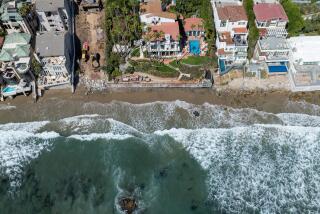O.C. Awaits State Aid in Battle of the Beach
- Share via
From their balconies, residents in the Seal Beach Surfside community can look out and enjoy what only seaside residents can boast of: sailboats, seabirds and even occasional migrating whales.
But right below those balconies, another important part of the view is disappearing: the beach.
Thanks to the ocean’s ebb and flow, tons of sand have slipped away, leaving million-dollar homes precariously exposed, waves crashing within 20 yards of the nearest home.
“It’s quite serious,” said homeowner Roger Kuppinger.
Surfside is not alone.
Erosion along the state’s 1,100-mile coastline is a gnawing problem; more so in urban residential communities like Surfside.
Orange County’s other shrinking sands include Huntington Beach bluffs, Salt Creek Beach Park in Dana Point, Capistrano Beach and San Clemente.
But a $10-million allocation signed by Gov. Gray Davis last week as part of the state’s $99.4-billion budget could help threatened beach areas.
Orange County cities hope to receive and use much of the money as vital matching funds for Army Corps of Engineers beach restoration projects. Those projects aim to prevent further erosion from storms, climate changes and man-made structures such as artificial jetties that block the natural flow of coastal sands.
Activists say money as well as sand will trickle away if the problem isn’t solved.
“Erosion has to be dealt with, or we’re going to lose a vital economic resource in the not too distant future,” said Steve Aceti, executive director of the California Coastal Coalition.
The coalition, composed of more than 30 coastal cities, has lobbied Sacramento and the federal government, saying erosion could not only threaten homes and property, but also local economies that de
pend on beach tourism.
California’s beaches generate an estimated $14 billion a year in direct revenue, according to a 1998 survey by the coalition.
For decades, Surfside residents have fought the problem, which was caused by the construction of a jetty by the corps in the 1940s to protect the Seal Beach Naval Weapons Station. The jetty blocks natural sand movement, meaning that lost sand isn’t replaced.
To offset the loss, the corps replenishes sand at Surfside every five to six years. The most recent project was in 1996, when the corps dredged 1.6-million cubic yards of sand, the equivalent of covering 900 football fields 1 foot deep.
Surfside is an important “feeder” beach--sand replenished there drifts south to Sunset Beach, Bolsa Chica State Beach, Huntington City Beach, Huntington State Beach and the shores of Newport Beach.
But the massive process costs $6 million to $10 million, with two-thirds paid by the federal government, and the remainder with state, county and local funds.
While the state has secured restoration funds for next year, Congress has not, said Gino Salegui, director of the Surfside Storm Water Tax District. He said it will be “an exciting winter” if the funds aren’t allocated.
In San Clemente, wide sandy beaches were the norm until 1983, when El Nino storms started a gradual loss of sand.
“We have less than one-half the beach width since 1983,” said San Clemente Marine Safety Capt. Lynn Hughes.
The beach has gotten so thin that pilings and a metal apron underneath lifeguard headquarters that were covered by sand for decades are now exposed.
“The structure is safe,” said Hughes, “but the concern is for swimmers’ safety if they got swept into [the metal apron].”
Two years ago, beach restroom facilities were temporarily closed after waves gouged an 8-foot drop-off in front of one, and began crashing against the walls of another.
The eroding beach also poses a problem for lifeguards in jeeps, who have to steer a gantlet of incoming surf and boulders put in place to try to retain the disappearing sands.
The city and the corps are conducting a preliminary study to assess the damage, which could lead to a four-year investigation of problems, causes, and solutions.
But it could be two to three years after that before the project is put out for bid, Hughes said.
“There’s not a quick fix to this issue,” he said.
In the meantime, the city is negotiating with a local contractor to truck in 30,000 cubic yards of sand to protect city beaches for the fall, he said.
Though the $10 million in the new budget seems small for a statewide array of projects, Orange County officials are glad that the importance of the state’s coastline is being recognized by legislators.
“It signals that this is a California resource,” said Steven Badum, Seal Beach city engineer. “You can’t just let these beaches erode away.”
More to Read
Sign up for Essential California
The most important California stories and recommendations in your inbox every morning.
You may occasionally receive promotional content from the Los Angeles Times.










